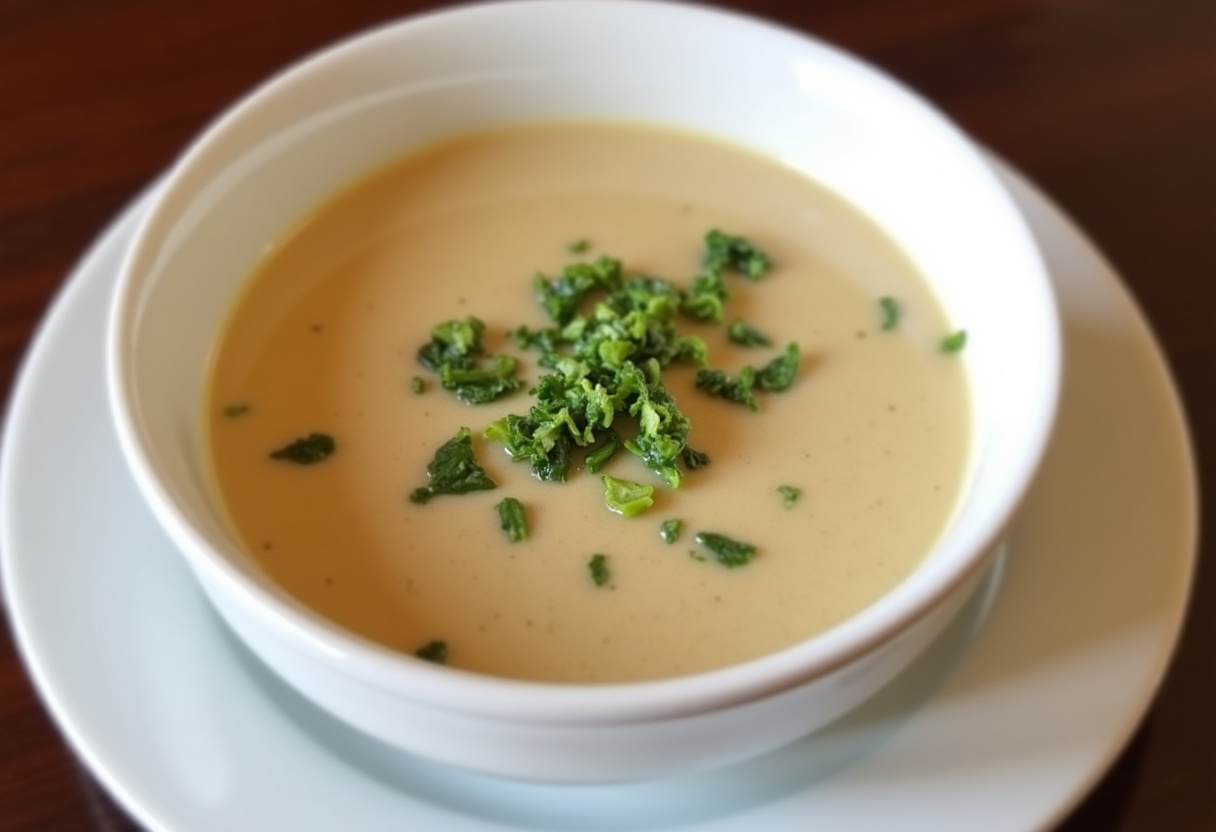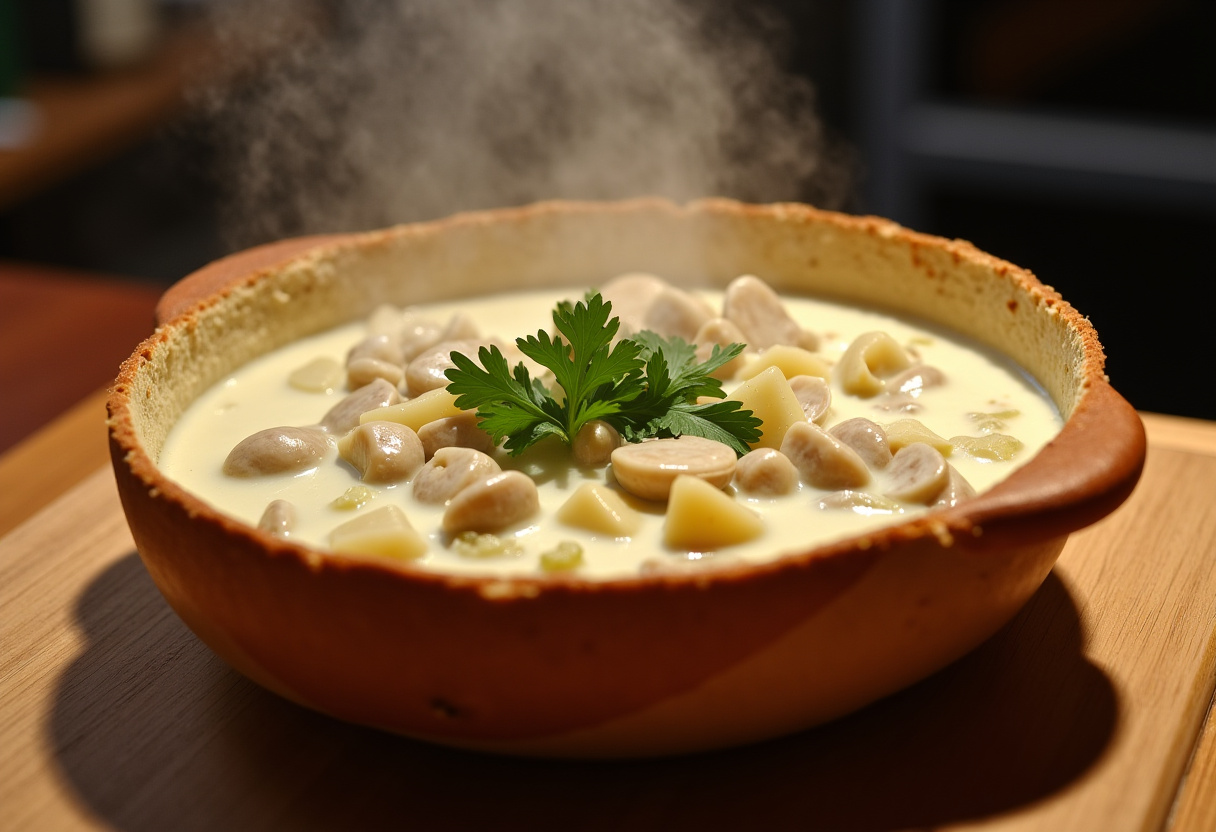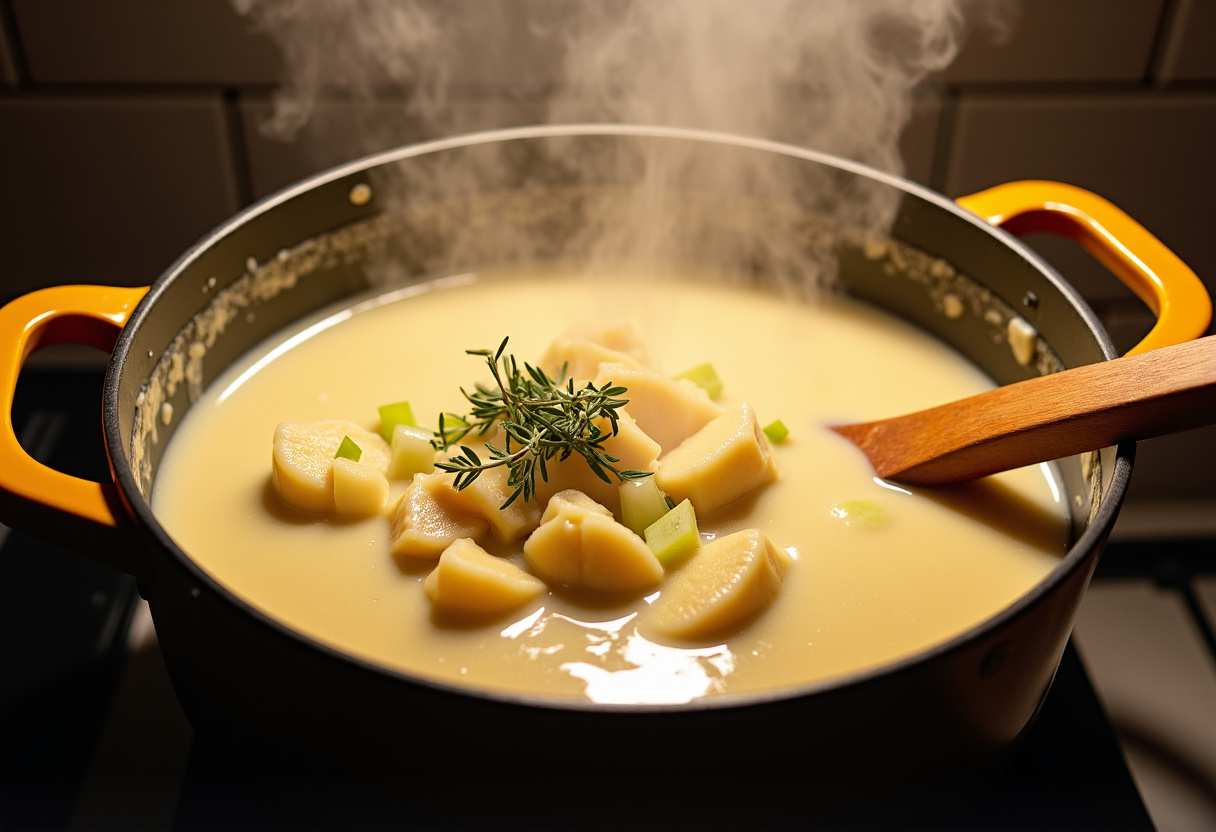New England Clam Chowder: A Creamy, Comforting Bowl of Coastal Bliss 🍲🌊✨
1. Introduction
There’s nothing quite like a steaming bowl of New England Clam Chowder to warm your soul on a chilly evening. This iconic American soup traces its roots back to the early 18th century when French and British settlers adapted their traditional chowder recipes using local ingredients. The creamy, rich, and flavorful soup we know today became a staple in coastal communities, with each New England state developing its own subtle variations.
What makes this best New England clam chowder recipe so special is its perfect balance of tender clams, diced potatoes, smoky bacon, and aromatic vegetables in a velvety cream base. The combination creates a symphony of textures and flavors that’s both comforting and sophisticated. Whether you’re craving a taste of the coast or simply want a satisfying meal that feels like a warm hug, this chowder delivers perfection in every spoonful.

2. Ingredients
To make the best New England clam chowder that would make any New England grandmother proud, you’ll need the following carefully selected ingredients:
- 4 cups fresh clams (or 2 cans chopped clams with juice) – For the freshest flavor, consider getting littleneck or cherrystone clams from your local fish market
- 4 slices thick-cut bacon, diced – The smoky flavor is essential for authentic New England taste
- 1 large onion, finely chopped – Yellow onions work best for their balanced sweetness
- 2 celery stalks, diced – Adds a subtle earthy flavor and pleasant crunch
- 3 medium potatoes, peeled and diced – Yukon Gold potatoes are ideal for their creamy texture
- 3 cups clam juice (or seafood stock) – This forms the flavorful base of your chowder
- 2 cups heavy cream – Creates that signature rich, velvety texture
- 1/2 cup whole milk – Helps balance the richness of the cream
- 3 tbsp butter – Unsalted is best so you can control the seasoning
- 2 tbsp all-purpose flour – For thickening the chowder to perfect consistency
- 1 tsp fresh thyme – Dried can be substituted but use half the amount
- 1 bay leaf – A classic aromatic that adds depth
- Salt and black pepper to taste – Freshly ground pepper makes a difference
- Fresh parsley, chopped (for garnish) – Adds color and a fresh note
- Oyster crackers (optional, for serving) – A traditional New England accompaniment
For those looking for alternative ingredient options or additional inspiration, check out this excellent New England Clam Chowder recipe that offers some creative variations on the classic.
3. Step-by-Step Instructions
Step 1: Sauté the Bacon and Vegetables
In a large heavy-bottomed pot or Dutch oven (a 5-6 quart size works well), cook the diced bacon over medium heat until crispy and golden brown, about 5-7 minutes. The rendered bacon fat will become the flavorful foundation of your chowder. Using a slotted spoon, transfer the crispy bacon bits to a paper towel-lined plate, leaving the delicious fat in the pot.
Add the chopped onion and celery to the bacon fat, sautéing until softened and translucent (about 5 minutes). Stir frequently to prevent burning. The vegetables should be tender but not browned. Now add the butter and let it melt completely before sprinkling in the flour. Cook this roux mixture for about 2 minutes, stirring constantly to eliminate any raw flour taste. This step is crucial as it will thicken your chowder to that perfect creamy consistency New England chowder is famous for.

Step 2: Simmer the Potatoes and Clam Juice
Add the diced potatoes to the pot along with the clam juice (or seafood stock if using). The liquid should just cover the potatoes – if it doesn’t, you can add a bit of water or additional stock. Bring the mixture to a gentle boil over medium-high heat, then immediately reduce the heat to maintain a steady simmer. Cover the pot partially and let it cook until the potatoes are just tender when pierced with a fork, about 15 minutes.
Stir in the thyme and bay leaf at this stage. These herbs will infuse the chowder with their aromatic flavors as it simmers. Be sure to taste a piece of potato to check for doneness – it should be cooked through but still hold its shape. Overcooked potatoes will turn mushy in the finished chowder.

Step 3: Add the Clams and Cream
Once the potatoes are perfectly tender, it’s time to add the star ingredient – the clams! Stir in the clams along with their juice (if using canned) and the reserved crispy bacon. Now slowly pour in the heavy cream and milk, stirring gently to combine all the ingredients. Reduce the heat to low and let the chowder simmer very gently for another 10 minutes to allow the flavors to marry.
This is a critical stage where patience pays off. Avoid the temptation to boil the chowder at this point, as high heat can cause the dairy to separate or curdle. You want to maintain just enough heat to keep it steaming gently. Season with salt and freshly ground black pepper to taste, remembering that the clams and bacon already contribute some saltiness.

Step 4: Serve and Enjoy
Before serving, don’t forget to remove the bay leaf – it’s done its job and isn’t pleasant to bite into! Ladle the hot chowder into warmed bowls, ensuring each serving gets plenty of clams, potatoes, and that creamy broth. Garnish with a generous sprinkle of fresh parsley for color and freshness.
For the full New England experience, serve with oyster crackers or slices of crusty sourdough bread for dipping. If you’re feeling particularly indulgent, hollow out a small round loaf of bread to create an edible bread bowl – it makes for a stunning presentation and adds to the rustic charm of this coastal classic. The bread soaks up the delicious broth and becomes part of the meal!

4. Tips for the Best New England Clam Chowder
- Use fresh clams when possible – While canned clams work well, fresh clams (steamed and chopped) provide superior flavor and texture. If using fresh, save the steaming liquid to use as part of your clam juice.
- Don’t skimp on the bacon – The smoky depth from quality thick-cut bacon is what separates good chowder from great chowder. For an extra layer of flavor, try using applewood-smoked bacon.
- Control your heat – After adding dairy, maintain just below a simmer to prevent curdling. If you notice separation, whisk vigorously or blend briefly with an immersion blender.
- Rest before serving – Letting the chowder sit for 10-15 minutes off heat allows flavors to develop fully and the consistency to perfect itself.
- Reheat with care – Always reheat leftovers gently over low heat, stirring frequently. Add a splash of milk if the chowder has thickened too much in the fridge.
- Season thoughtfully – Taste as you go, remembering that flavors concentrate as the chowder reduces. You can always add more salt but can’t take it out!
5. Variations
While purists might argue for sticking to tradition, there’s room for creativity with this best New England clam chowder recipe:
- Manhattan-style variation: Swap the cream for crushed tomatoes and add diced bell peppers for a completely different but equally delicious red chowder.
- Spicy kick: Add a pinch of cayenne, diced jalapeños, or a dash of hot sauce for those who like heat with their seafood.
- Seafood medley: Include shrimp, scallops, or lump crab meat along with the clams for an extra luxurious version.
- Lightened-up version: Substitute half-and-half or whole milk for the heavy cream, though the texture will be slightly less rich.
- Herb-infused: Add a sprig of fresh rosemary or tarragon along with the thyme for additional herbal notes.
- Corn chowder hybrid: Stir in fresh or frozen corn kernels along with the potatoes for a sweet contrast.
6. Serving Suggestions
This best New England clam chowder is satisfying enough to stand alone as a meal, but pairs beautifully with:
- Crusty sourdough bread or garlic toast – Perfect for sopping up every last drop of creamy broth
- A crisp green salad with lemon vinaigrette – The acidity cuts through the richness
- Grilled cheese sandwiches – Especially with sharp cheddar for the ultimate comfort food combo
- Steamed mussels or clams – For a spectacular seafood feast
- A chilled glass of Chardonnay or a crisp lager – The perfect beverage pairing
- Oyster crackers – A traditional New England accompaniment that adds pleasant crunch
For more delicious dinner ideas that pair well with chowder, explore our collection of dinner recipes that complement this coastal classic.
7. Storage and Reheating
Proper storage is key to maintaining the quality of your leftover chowder:
- Refrigeration: Store in an airtight container in the refrigerator for up to 3 days. The flavors often improve after a day as they meld together.
- Reheating: Gently reheat on the stovetop over low heat, stirring frequently to prevent scorching. If the chowder has thickened too much, whisk in small amounts of milk or cream until desired consistency is reached.
- Freezing: Freezing is not recommended due to the dairy content which can separate when thawed. The potatoes may also become grainy in texture.
- Make-ahead tip: You can prepare the base (through step 2) up to a day in advance, then add the clams and cream just before serving for the freshest taste and texture.
8. Frequently Asked Questions
Can I use frozen clams? Yes, frozen clams can be used in a pinch. Thaw them completely in the refrigerator overnight and drain any excess liquid before adding to the chowder. However, fresh or canned clams will provide better texture.
How do I thicken my chowder if it’s too thin? If your chowder needs more body, you have several options: 1) Simmer uncovered to reduce and concentrate the liquid, 2) Make a cornstarch slurry (1 tbsp cornstarch mixed with 2 tbsp cold water) and stir it in, or 3) Mash some of the cooked potatoes against the side of the pot to release their starch.
Can I make it ahead for a party? Absolutely! Prepare the chowder up through adding the potatoes and clam juice (step 2) up to a day in advance. About 30 minutes before serving, reheat the base, then proceed with adding the clams and cream.
What’s the difference between New England and Manhattan clam chowder? New England chowder is cream-based with potatoes, while Manhattan chowder is tomato-based and typically includes additional vegetables like carrots and celery. They’re completely different soups that happen to share clams as an ingredient.
Can I use bottled clam juice? Yes, bottled clam juice is perfectly acceptable and often easier to find than fresh. Look for it in the seafood section of your grocery store. If unavailable, you can substitute with seafood or fish stock, though the flavor won’t be quite as authentic.
9. Conclusion
This best New England clam chowder recipe is more than just a soup – it’s a bowl of coastal history, comfort, and culinary tradition. With its creamy texture, smoky bacon undertones, tender clams, and hearty potatoes, it represents the essence of New England cuisine in every spoonful. Whether you’re serving it as the star of a casual weeknight dinner or as the centerpiece of an elegant seaside-inspired gathering, this chowder is sure to transport your taste buds to the rocky shores of Maine with its rich, satisfying flavors.
The beauty of this recipe lies in its versatility – equally at home in a rustic bread bowl at a family table or served in delicate china at a dinner party. It’s a dish that bridges generations, with each bite evoking memories of coastal vacations, seaside shacks, and the simple pleasure of good food made with care. So gather your ingredients, take your time with each step, and prepare to enjoy one of America’s most beloved culinary classics. From our kitchen to yours – happy chowder making! 🥣🌿💙





No comment